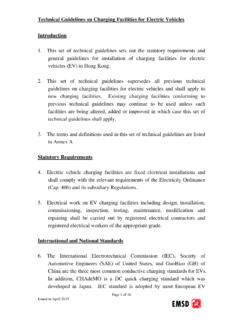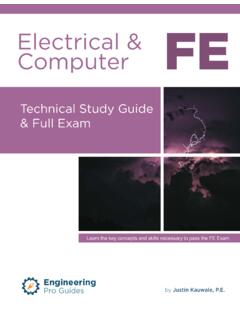Transcription of Mechanical Engineering Courses Syllabi
1 7/15/2020 Revision Mechanical Engineering Courses Syllabi This collection of Syllabi is based on a previous academic year (2019-2020) and is provided for general reference only. For the syllabus of any currently offered course, please check the course page on CourseWorks. If there is any conflict between a syllabus in this booklet and that posted on Courseworks , the syllabus on CourseWorks will apply. 2020 -2021 THE FU FOUNDATION SCHOOL OF Engineering AND APPLIED SCIENCE Columbia University - 2 - Syllabi Table of Contents EEME E4601: Digital Control Systems EEME E6601: Introduction to Control Theory MEBM E4439: Modeling and Identification of Dynamic Systems MEBM E4710: Morphogenesis: shape and structure in biological materials MEBM E6310: Mixt IXT THEORIES FOR BIOL TISSUES MECS 4510: Evolutionary Computation and Design Automation MECS 6616: Robot Learning ME E4058.
2 Mechatronics & Embedded Microcomputer Control MECE E4100 Mechanics of Fluids Course Meeting Times MECE E4210: Energy Infrastructure Planning MECE E4212: Microelectromechanical Systems MECE E4213: Bio-Microelectromechanical Systems (BioMEMS) MECE E4302: Advanced Thermodynamics MECE E4305: Mechanics and Thermodynamics of Propulsion MECE4306: Introduction to Aerodynamics MECE E4312: Solar Thermal Engineering MECE E4314: Energy Dynamics of Green Buildings MECH E4320: Introduction to Combustion MECE E4330: Thermofluid Systems Design MECE 4431: Space Vehicle Dynamics MECE-E4520: Data Science for Mechanical Systems MECE-E4603: Applied Robotics: Algorithms and Software MECE E4604: Product Design for Manufacturing MECE 4606: Digital Manufacturing MECE E4609: Computer Aided Manufacturing MECE E4610: Advanced Manufacturing Processes MECE E4611: Robotics Studio MECE E4811: Aerospace Human Factors Engineering MECE E4999: Fieldwork MECE E6100: Advanced Mechanics of Fluids MECE E6102: Computational Heat Transfer and Fluid Flow MECE E6104: Case Studies in Computational Fluid Dynamics MECE E6313: Advanced Heat Transfer MECE E6400: Advanced Machine Dynamics MECE E6422.
3 Intro-Theory of Elasticity MECE E6423: Introduction to the Theory of Elasticity II MEEM E6432: Small Scale Mechanical Behavior MECE E6617: Advanced Kinematics, Dynamics, and Control in Robotics MECE E6620: Applied Signal Recognition and Classification MEIE E4810: Intro to Human Space Flight MEMS Production and Packaging - 3 - EEME E4601 Digital Control Systems Syllabus Professor: Professor Richard Longman Primary contact: Email 1. Course Description: This course in digital control systems emphasizes all of the extra difficulties and considerations that are introduced by making use of a digital controller.
4 Digital controllers necessarily sample the error signal at sample times and updates the control action at the next sample. This introduces many issues about how to create input-output models in terms of difference equations, the influence of sampling on stability, and on signal fidelity including aliasing/folding, choice of sample rate, etc. Both classical control approaches and modern or state variable control approaches are treated. To have a complete picture of the design process it is best to take EEME E6601 or EEME E3601. These Courses can be taken either before or after taking digital control, but before is preferable.
5 2. Prerequisites: The main basis for the mathematics used is ordinary differential equation, and there is some use of linear algebra. Material in the course is intended to refresh your memory on these topics. 3. Required Textbook: Kuo, Benjamin C., Digital Control Systems, 2nd edition, Oxford University Press ISBM 0-1951-2064-7 Topics from throughout the book are covered, but the lecture topics can come from many places through the book in any order. Some homework assignments are from the book. There are also a number of handouts specifically prepared for the class on various useful topics.
6 5. Grading: One Midterm Exam 45%, Final (cumulative) Exam 45%, Homework 10%. 6. Assignments: Approximately weekly homework assignments. These are important, you need to struggle with the material in order to digest it, and also to be able prepared for the exams. 7. Exam Schedule: There are weekly 3-hour lectures. The midterm exam is usually given after the 8th lecture or the 7th lecture. Midterm exam is 3 hours. Final exam (cumulative) is normally scheduled after all lectures have been viewed, usually scheduled by the registrar. EEME E4601 Digital Control Systems Professor Longman LECTURE TOPICS, RELATED HANDOUTS, RELATED BOOK SECTIONS, HOMEWORK AND EXAM TIMING Text: Kuo, Benjamin C.
7 , Digital Control Systems, 2nd edition, Oxford University Press ISBM 0-1951-2064-7 Lecture 1: Introduction to feedback and digital feedback control. Block diagrams of different digital control systems. Conversion of classical feedback control laws to digital control laws Handout: (From textbook) Book: Chapter 1 Intro Chapter 2 pages 13-28, 55-67 (contains extra information) Lecture 2: Solution of homogeneous ordinary differential equations (ODE), and difference equations. How to make a homogeneous difference equation whose solution is the same at sample times as the differential equation. Digital controllers as difference equations, solution of homogeneous difference equations.
8 Desired properties of the solution, time constants, settling time, stability. Handout: Homework 1 Lecture 3: Forced response of difference equations. Particular solutions of ODE and difference equations. Laplace transfer functions, ODE and transfer functions conversion, and block diagrams. Z-Transforms and z-transfer functions, conversions, block diagrams, z-transfer functions of discrete PID controllers. Particular solutions of difference equations. Handout: (from book) Lecture 4: More discussion of solutions of ODE and difference equations, both homogeneous and particular. Block diagram algebra when all blocks are z-transfer functions.
9 Laplace transforms, solution of difference equations using z-transforms. A root locus plot tuning the controller gain. Interpretation: for stability and settling time. Book: Chapter , , ; Chapter 4, pp. 124-129 Chapter on z-transforms Homework 2 Lecture 5: Block diagram manipulation, converting a differential equation ( the plant) fed by a zero-order hold, to a equivalent difference equation, finding system response using z-transfer functions. Rule 1 and Rule 2. Use of transform table to convert ODE to difference equations, and make block diagram contain only samples - 4 - signals eliminating A/D and D/A.
10 Block diagram algebra to get closed loop difference equation. Partial fraction expansions. Handout and Book: (again) Book: Chapter Lecture 6: More discussion: Converting continuous elements following zero order holds to digital form. Block diagram manipulation for different cases. Finding closed loop difference equation. Aliasing. Handout: Homework 3 MIDTERM EXAM Handout: Lecture 7: Design process: choice of controller, conversion to digital plant, finding closed loop difference equation. Three parts to the solutions: solution of homogeneous equation, particular solution for commands, particular solution for disturbances.



